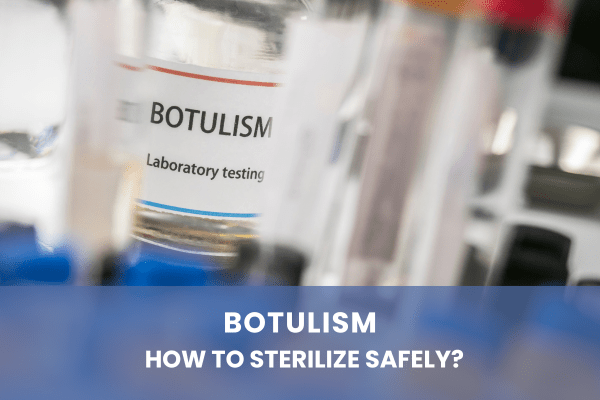Botulism: how to sterilize safely?

Heat sterilization enables food to be stored for up to several months or even years without the use of chemical preservatives. Sterilization poses a risk if it is not carried out under optimal hygienic conditions and if the appropriate time and temperature parameters are not followed.
Some spores of microorganisms can resist heat and produce toxins that are dangerous for human health. This is the case with botulism, a serious illness caused by the botulinum toxin produced by the Clostridium botulinum bacteria.
A rare disease in France, it can occur as a result of consuming food that has not been sufficiently sterilized, whether it is done so in an artisanal or industrial way. This is what happened in Bordeaux in September 2023, where fifteen people fell victim of botulism after eating homemade sardines in oil in a restaurant. One person died and several were remained hospitalized in intensive care.
The health authorities identified the bacteria responsible in a glass jar of sardines in oil and issued a warning to people who had visited the same establishment.
Botulism: rules for home sterilization
Sterilizing by heat is a food preservation method that involves submitting them to high temperatures for a sufficient duration to kill bacteria and their spores. To avoid botulism, it is essential to follow basic rules:
- Use fresh foods with good microbiological quality.
- Clean thoroughly all used utensils and containers.
- Do not overfill the containers.
- Seal the lids tightly.
- Follow the recommended sterilization temperatures and durations.
The processing parameters of sterilization depend on the type of food to be preserved.
For acidic foods (pH less than 4.5), such as fruits, they are naturally more resistant to botulism. Sterilization by boiling water (100°C) for a time adapted to the packaging format and the product concerned is sufficient.
For low-acid foods (pH greater than 4.5), such as meat, fish, and cooked vegetables, it must be sterilized at a higher temperature to kill Clostridium botulinum spores. Sterilization under pressure with a temperature above 100°C is recommended. The required process will depend on the product and its format, with average temperatures being around 120°C.
Botulism: sterilization in industrial autoclave
The industrial autoclave sterilization is the most effective method of sterilization to kill the Clostridium botulinum bacteria responsible for botulism. The industrial autoclave can reach much higher temperatures than a household autoclave, ensuring the destruction of pathogens.
The industrial device guarantees excellent temperature distribution in its vessel and cycle repeatability, which is a guarantee of safety for safe sterilization.
Botulism: safety tips
Even if the process, whether it is “home” or industrial, must be scrupulously respected, it is advisable not to consume preserves that have leaked during sterilization or that show signs of deterioration: deformation of the lid, swelling of the container or abnormal odor in particular…
The Steriflow autoclave: sterilize with confidence
Steriflow offers a wide range of autoclaves for professionals in the food industry with diameters ranging from 900 mm to 2,300 mm and capacities ranging from 1 to 12 baskets. These devices, by their design, ensure excellent temperature homogeneity in the vessel, guaranteeing uniform sterilization of all products in the load. The control command secures the food process and guarantees perfect cycle repeatability.
In addition, a team of experts supporting you in the use of your autoclave for safe and optimized product sterilization.
